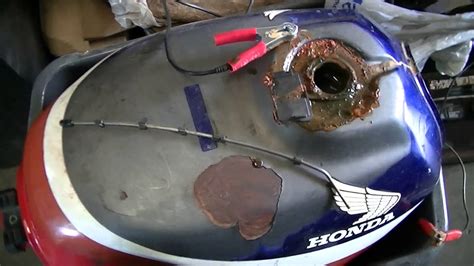Get Rid of That Ugly Rust: Motorcycle Gas Tank Cleaning Guide
That rusty motorcycle gas tank? Don't let it ruin your ride! A rusty fuel tank can cause serious engine problems, from clogged carburetors to fuel starvation. But before you shell out money for a replacement, know that many rusty tanks can be salvaged with a little elbow grease and the right techniques. This comprehensive guide will walk you through the process of cleaning your motorcycle gas tank and getting it back to its former glory.
Why is My Gas Tank Rusty?
Before we dive into cleaning, let's understand why rust forms in the first place. Moisture is the culprit. Even a seemingly dry tank can harbor condensation, especially if it's been sitting unused for a while. This moisture, combined with the iron in the steel tank, creates the perfect environment for rust to develop. Poor fuel quality and leaving the tank empty can also exacerbate the issue.
How Can I Prevent Rust in the Future?
Preventing future rust is just as important as cleaning existing rust. After cleaning, always keep your gas tank full of fuel, ideally with a fuel stabilizer added, to prevent condensation. Consider using a fuel tank sealant as an extra layer of protection. Regularly inspecting your tank for any signs of rust or corrosion is crucial for early intervention.
Assessing the Damage: How Much Rust Are We Talking?
The cleaning method you choose will depend on the severity of the rust.
- Light Surface Rust: This is the easiest to deal with and often requires only a simple cleaning with a chemical rust remover.
- Moderate Rust: You'll likely need a more aggressive approach, potentially involving a combination of chemical cleaning and mechanical scrubbing.
- Severe Rust: If the rust is heavily pitted or has compromised the tank's integrity, it might be beyond repair. Consider replacing the tank in these cases.
Cleaning Your Motorcycle Gas Tank: A Step-by-Step Guide
This guide assumes you've drained all the fuel from the tank. Safety first! Always work in a well-ventilated area, and wear appropriate safety gear, including gloves and eye protection.
1. Preparation: Removing Loose Rust and Debris
Start by thoroughly rinsing the inside of the tank with water. This will remove loose rust particles and debris. You can use a garden hose or a pressure washer (carefully!), but ensure all the water is drained completely afterward.
2. Chemical Cleaning: The Power of Rust Removers
Several effective chemical rust removers are available. These are typically acidic solutions that dissolve the rust. Follow the manufacturer's instructions carefully, as different products have different application methods and safety precautions. After applying the remover, allow sufficient time for it to work (often several hours or overnight), then thoroughly rinse the tank with clean water.
3. Mechanical Cleaning: For Stubborn Rust
For stubborn rust that resists chemical cleaning, you might need to employ mechanical methods. This could involve using a rotary wire brush attachment on a drill or a specialized gas tank cleaning tool to scrub away the rust. This process can be time-consuming and requires patience, but it's often necessary to achieve a smooth, clean surface.
4. Rinsing and Drying: The Final Touches
Once you've finished the chemical and mechanical cleaning, rinse the tank thoroughly with clean water multiple times to remove all traces of the cleaning solutions and rust particles. Then, allow the tank to dry completely. You can use compressed air to speed up the drying process.
5. Sealing and Protecting: The Long-Term Solution
After cleaning and drying, apply a fuel tank sealant to protect the tank from future rust. This will create a barrier between the metal and the fuel, preventing moisture from causing further corrosion. Follow the sealant manufacturer's instructions carefully for best results.
What If My Tank Has Holes?
If your tank has holes due to severe rust, welding or professional repair might be necessary. This is best left to experienced professionals who have the expertise and equipment to repair damaged metal.
Can I Use Vinegar to Clean My Gas Tank?
While vinegar (acetic acid) has some rust-removing properties, its effectiveness is limited compared to commercial rust removers. It's generally not recommended for severely rusted tanks but might be suitable for light surface rust as a less aggressive alternative.
What Kind of Sealant Should I Use?
Various fuel tank sealants are available, including those designed specifically for motorcycle gas tanks. Choose a high-quality sealant that is compatible with gasoline and offers strong protection against rust and corrosion. Always follow the manufacturer's instructions for proper application.
By following these steps, you can breathe new life into your rusty motorcycle gas tank, saving money and ensuring your bike runs smoothly for many miles to come. Remember, prevention is key, so always keep your tank full and protected to avoid future rust problems.

